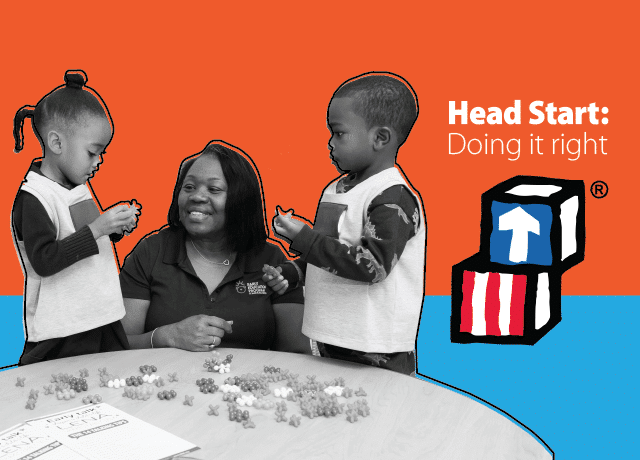There’s a lot that goes into creating high-quality early childhood education. One simple yet powerful ingredient is a focus on fostering teacher-child interactions and creating robust language environments.
Increasing the number of conversational turns children aged 0-5 experience is among the easiest and most cost-effective ways to improve their futures. Conversational turns build children’s brains, and strong evidence links them to long-term positive outcomes.
With more than half of all U.S. children aged 0-5 attending child care, teaching teachers about the power of early talk is critical. So, too, is advocating for structural program improvements and policy enhancements that will create the ideal environment for lots and lots of conversational turns.
One program model that shows tremendous promise: Head Start.
How do HS/EHS language environments compare?
On average, children in Head Start and Early Head Start programs experience much more interactive talk with their teachers than children in other child care settings. That’s based on data analysis from over 24,000 daylong audio recordings from children aged two to 36 months.
- Compared to children in other child care settings, HS/EHS attendees are almost three times more likely to experience 40 conversational turns per hour. Researchers at LENA have established 40 turns per hour as an optimal number, linked to higher cognitive and language outcomes 10 years down the road.
- Infants in Early Head Start classrooms engage in approximately 35 percent more conversational turns than children in other child care settings. What’s more, infants in EHS experience more interaction than infants who stay at home with their parents or other primary caregivers.
- In non-Head Start settings, more than one in five children spends most of their days in language isolation, experiencing fewer than five conversational turns per hour. By comparison, approximately one in 10 HS/EHS children experiences language isolation. (Is that still one too many? Absolutely! But it’s still a strong indication that Head Start is doing something right.)
- On average, children living in neighborhoods described as having low socioeconomic status experience fewer conversational turns than children living in high-SES neighborhoods. Head Start effectively negates this SES effect. For children aged 0-24 months, those attending Head Start experience more conversational turns than those attending non-Head Start centers in high-SES settings. Two-year-olds experience nearly equivalent levels of interaction in the two settings.
What does this mean for Head Start/Early Head Start?
There’s still a clear opportunity to support Head Start educators in achieving even higher levels of interactive talk. There’s also a clear opportunity to ensure equitable experiences for individual children within single classrooms.
That said, we would be remiss not to advocate for funding levels that allow more children to access Head Start as it stands now. HS/EHS is absolutely one of best — if not the best — child care environments for children in the U.S. Quantitative measures of adult-child interactions, like the ones described above, are strong indicators of classroom quality. Head Start is clearly a model program in that regard.
Budgetary cuts to Head Start/Early Head Start would deprive children of high-quality early education, would compromise the factors that foster high-quality care, and would jeopardize the effectiveness of Head Start on child outcomes.
[callout]



